I was not sure if to post this into "analogue source" or "tube section" of the forum, so admin feel free to move this where it belongs 😀
Based on my previous tube riaa phono preamp with passive correction I wanted to build something a bit better. I was very satisfied with the previous one, however as I was building new line preamp, I wanted to match the look and also performance of my newly built tube line preamp. So I took a challenge and tried to upgrade the RIAA and tried to make way better, the best I could, and I did!!!
A lot is very same as in my line level preamp, all the mechanics, shielding, pcb layout and power supply. So if you want details go to check that one. The main difference here is, the PSU works on higher voltage and is even more filtered with CRC (22mF+1R+22mF) for tube filaments and CRCRC (3x220uF+2x470R) for tube plates. All regulated with LDO regulators with even higher capacities, everywhere further filtered with polypropylenes etc. As cathodes of some valves are quite high here (+150V) I had to elevate heater power supply, this brings a small complication as extra transformer winding is needed for powering controls, relays and timers.
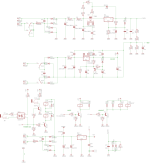
RIAA
I wanted to make it kind of voodoo-hi-end sort of, in a sense some things may not be fully in line with what I believe is necessary, but I did it anyway to make it the best 😀
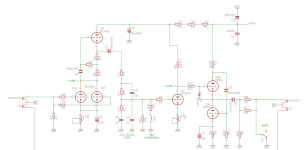
In the input stage there are three ECC803S triodes connected as u-follower. Two parallel connected triodes creating input and one as follower on top...
The only biggest disadvantage of this solution is very high input miller capacity in range of ~300pF, but as this value fits majority of MM pickups I took this tradeoff for very low noise, higher transconductance and gain. The output follower feeds passive RIAA network thru Mundorf Oil cap 🧙♀️I was able to design correction so precisely in one go, that I have reached +-0,1dB RIAA error in 20Hz-20kHz with -2dB@80kHz. I have implemented also reed relay switch to have possibility to change correction to "somehow" get close to what is called as "IEC RIAA", well its not exact in any way but makes -3dB@20Hz, sort of "rumble filter" or so. After the correction, there is simple amp stage with ecc803s feeding the white cathode follower by E88CC to easily drive line level loads.
I know I know, for "low noise I should use hi-mu valves" at the input, but in my testing the gain was not sufficient and noise very much matched gain, so lower gain lower noise but then had no gain... so I decided 83 (12AX7) would be the best valve for this. I tested like 50 different tubes here (several ECC88,85, ECC83 RFT, 6N2P etc...), long story short - only the ECC803S are usable in terms of low-noise and microphonics in gain I needed. See the picked "premium" 6n2p noise compared to RFT ECC83, just on open bench, no shielding:
Then I found 803s is even lower and way less microfonic so it was decided.
For simple on/off and mute delay I made separated control board. Nothing special...
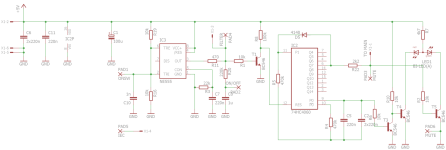
Below a few pictures from the build:


and more...
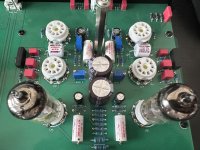

Case and mechanics as I explained follows my previous build, but in short... there is tripple shielded suspended and potted transformer, floating style pcb placement with both sides full access = the heaven for modification 😀 etc... what I added extra here is the "dampener" for tube tops, (inspired from mcintosh preamps 😀 ) not that it was needed as ecc803s are absolutely not microfonic in any way, but just for better feeling 😎
To be able to properly measure and test, I built inverse RIAA passive network in shielded box:
the QR code was maybe nice idea, but then I realised its wrong so need to print a new one 🤣
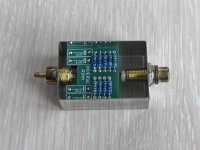

Then I've created custom calibration in REW for it based on mathematically exact RIAA curve and measured preamp correction error which looks like this:

and finally, fully covered preamp spectrum measured...
overall gain is 46dB which is on a higher side for phono, however usefull for low level MM pickups at least. Below is 5mV input, 0dBV calibrated output into 10k load (buffered cosmos adc). With higher output pickups output it will get easily to over 2VRMS which futher loweres the signal to noise ratio...
Please note there is no negative feedback loop in this preamp!

speaking of noise, input shorted with 47R, output directly into cosmos adc, 0dBV calibrated below:
note the mains noise here is non existent = battery like power supply and this is with +65dB gain @50hz 😎

and at the end... how it sounds...
well, good 😀 not that I can recognise the difference, but measures nicely 🤣
The noise is different story tho, I have never ever heared tube phono with so low noise. You can dirrectly connect it to power amp, turn volume to max. and hear just very tiny hiss.... this is absolutely mindblowing to me as compared to others tube phonos, which sounds like waterfall compared to this one...

Based on my previous tube riaa phono preamp with passive correction I wanted to build something a bit better. I was very satisfied with the previous one, however as I was building new line preamp, I wanted to match the look and also performance of my newly built tube line preamp. So I took a challenge and tried to upgrade the RIAA and tried to make way better, the best I could, and I did!!!
A lot is very same as in my line level preamp, all the mechanics, shielding, pcb layout and power supply. So if you want details go to check that one. The main difference here is, the PSU works on higher voltage and is even more filtered with CRC (22mF+1R+22mF) for tube filaments and CRCRC (3x220uF+2x470R) for tube plates. All regulated with LDO regulators with even higher capacities, everywhere further filtered with polypropylenes etc. As cathodes of some valves are quite high here (+150V) I had to elevate heater power supply, this brings a small complication as extra transformer winding is needed for powering controls, relays and timers.

RIAA
I wanted to make it kind of voodoo-hi-end sort of, in a sense some things may not be fully in line with what I believe is necessary, but I did it anyway to make it the best 😀

In the input stage there are three ECC803S triodes connected as u-follower. Two parallel connected triodes creating input and one as follower on top...
The only biggest disadvantage of this solution is very high input miller capacity in range of ~300pF, but as this value fits majority of MM pickups I took this tradeoff for very low noise, higher transconductance and gain. The output follower feeds passive RIAA network thru Mundorf Oil cap 🧙♀️I was able to design correction so precisely in one go, that I have reached +-0,1dB RIAA error in 20Hz-20kHz with -2dB@80kHz. I have implemented also reed relay switch to have possibility to change correction to "somehow" get close to what is called as "IEC RIAA", well its not exact in any way but makes -3dB@20Hz, sort of "rumble filter" or so. After the correction, there is simple amp stage with ecc803s feeding the white cathode follower by E88CC to easily drive line level loads.
I know I know, for "low noise I should use hi-mu valves" at the input, but in my testing the gain was not sufficient and noise very much matched gain, so lower gain lower noise but then had no gain... so I decided 83 (12AX7) would be the best valve for this. I tested like 50 different tubes here (several ECC88,85, ECC83 RFT, 6N2P etc...), long story short - only the ECC803S are usable in terms of low-noise and microphonics in gain I needed. See the picked "premium" 6n2p noise compared to RFT ECC83, just on open bench, no shielding:
Then I found 803s is even lower and way less microfonic so it was decided.
For simple on/off and mute delay I made separated control board. Nothing special...

Below a few pictures from the build:
and more...


Case and mechanics as I explained follows my previous build, but in short... there is tripple shielded suspended and potted transformer, floating style pcb placement with both sides full access = the heaven for modification 😀 etc... what I added extra here is the "dampener" for tube tops, (inspired from mcintosh preamps 😀 ) not that it was needed as ecc803s are absolutely not microfonic in any way, but just for better feeling 😎
To be able to properly measure and test, I built inverse RIAA passive network in shielded box:
the QR code was maybe nice idea, but then I realised its wrong so need to print a new one 🤣


Then I've created custom calibration in REW for it based on mathematically exact RIAA curve and measured preamp correction error which looks like this:
and finally, fully covered preamp spectrum measured...
overall gain is 46dB which is on a higher side for phono, however usefull for low level MM pickups at least. Below is 5mV input, 0dBV calibrated output into 10k load (buffered cosmos adc). With higher output pickups output it will get easily to over 2VRMS which futher loweres the signal to noise ratio...
Please note there is no negative feedback loop in this preamp!
speaking of noise, input shorted with 47R, output directly into cosmos adc, 0dBV calibrated below:
note the mains noise here is non existent = battery like power supply and this is with +65dB gain @50hz 😎
and at the end... how it sounds...
well, good 😀 not that I can recognise the difference, but measures nicely 🤣
The noise is different story tho, I have never ever heared tube phono with so low noise. You can dirrectly connect it to power amp, turn volume to max. and hear just very tiny hiss.... this is absolutely mindblowing to me as compared to others tube phonos, which sounds like waterfall compared to this one...
Last edited:
Correction - there is no global negative feedback in the amp, there are local feedback loops. GNFB can boost performance considerably if used carefully, and at the low signal levels of a phono cartridge it should be straightforward to improve the THD using it.
The low mains noise is very impressive in a valve circuit - I struggle to get that without battery operation out in the wilds with solid state(!)
If you want a comparison point, here's what my miniaturized NE5534A circuit can get, only a few cm^2 of circuit board and all SMT - signal 5mV RMS, gain ~39dB

That's with a shorted input, with 820R and 500mH dummy cartridge on the input for more realistic assessment of noise, I get:

Which is clearly showing some interference pickup from the inductors I used acting as RF antennas, alas! It might be interesting if you can redo the noise floor measurement with an actual cartridge attached on the input to see how big of an HF hump you get, and how clean it is from mains interference then.
The low mains noise is very impressive in a valve circuit - I struggle to get that without battery operation out in the wilds with solid state(!)
If you want a comparison point, here's what my miniaturized NE5534A circuit can get, only a few cm^2 of circuit board and all SMT - signal 5mV RMS, gain ~39dB
That's with a shorted input, with 820R and 500mH dummy cartridge on the input for more realistic assessment of noise, I get:
Which is clearly showing some interference pickup from the inductors I used acting as RF antennas, alas! It might be interesting if you can redo the noise floor measurement with an actual cartridge attached on the input to see how big of an HF hump you get, and how clean it is from mains interference then.
I have also another tube riaa with riaa in feedback loop and its uncomparable with the passive one sound-wise. I think this is separated long topic for discussions and personal preference, but based on my testing I've found that the passive one is the way to go. Also OPamp passive phonos often outperform feedback ones...GNFB can boost performance considerably if used carefully, and at the low signal levels of a phono cartridge it should be straightforward to improve the THD using it
there are local feedback loops
Can you please elaborate what specifically you mean? where? If the cathode resistors alone - I do not consider that as "true" feedback loop...
It might be interesting if you can redo the noise floor measurement with an actual cartridge attached on the input to see how big of an HF hump you get, and how clean it is from mains interference then.
With real MM connected, below is my Technics SL-Q33 with Audio-technica at-410e/occ in "cue" = unmuted... well I am very surprised 😀 was expecting some mains spike or something as turntable has unshielded EI transformer in it, but this answers me I do not need to make external PSU for it as I was planning 😀 😀 😀
Last edited: